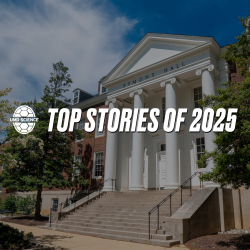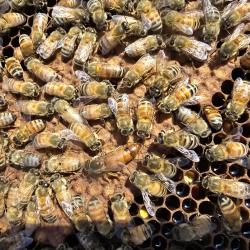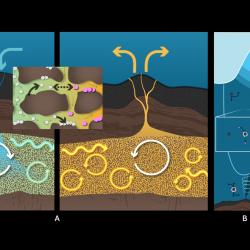Undergraduate Astronomer Observes Rare Eclipsing Event Between Faraway Asteroids
Junior astronomy and anthropology dual-degree student Oliver O’Brien was on an undergraduate team that analyzed two eclipsing asteroids in Jupiter’s Trojan asteroid belt, celestial ‘fossils’ that may contain the history of our solar system’s birth.

When images of a distant asteroid called 617 Patroclus dimmed across Oliver O’Brien’s computer screen, they knew that they were witnessing something rare.
“We were observing what’s called ‘mutual events’ between Patroclus and another similarly sized asteroid in its orbit called Menoetius,” recalled O’Brien, a University of Maryland junior astronomy and anthropology dual-degree student who is the second author of a recent paper detailing the observations. “These two asteroids circle each other every 103 hours, but once in a while, they pass in front of each other or shadow each other from our perspective. We knew we only had one chance at capturing these mutual events within our time constraints.”
As they studied the asteroids, O’Brien and their classmates weren’t just completing an assignment for their ASTR 498: Special Problems in Astronomy class on stellar and high-energy astrophysics with Astronomy Principal Lecturer Melissa Hayes-Gehrke—they were collecting and analyzing data that could influence the flight plan of a billion-dollar NASA mission. The team’s goal was to use the data collected from their observations of the asteroids Patroclus and Menoetius to help NASA’s Lucy researchers gain a better idea of what the Lucy spacecraft would encounter at the Jupiter Trojan asteroid belt during its planned flyby in 2033.
“There were a few discrepancies between the brightness and timing of the event, which is exciting because that means there’s something new to discover, more theories to explore,” O’Brien noted. “We believe that there’s probably an unknown variable within Patroclus’ and Menoetius’ system that’s contributing to that difference, maybe more complex asteroid shapes or orbit irregularities that we haven’t accounted for.”

NASA’s Lucy spacecraft, launched in 2021, will pass by Patroclus as it makes its journey through Jupiter’s Trojan asteroid belt years from now. But mission planners need detailed information—crucial details such as the asteroids’ sizes, shapes and orbital patterns—before its arrival to map a safer, more efficient flight plan. Using remote telescopes based in Australia’s Siding Spring Observatory, O’Brien studied the asteroids’ changing brightness as they eclipsed and occluded each other and compared the light curves with predictions that the team already made to better understand Patroclus and its surroundings.
The observing nights came with significant challenges. Technical glitches and focusing malfunctions left many images looking like “huge doughnut shapes instead of small points of light,” according to Hayes-Gehrke, first author of the paper and O’Brien’s advisor on the project.
However, rather than give up, O’Brien took the lead.
“Oliver worked painstakingly to get all the work done properly,” Hayes-Gehrke said. “They patiently redid the analysis several times with many alterations to improve the outcome. And the finished results were amazing.”
For O’Brien, spending hours addressing the glitches and errors was more than just a school project—O’Brien believes the team’s findings helped to reveal patterns in the sky that tell a story billions of years in the making.
“The main driving force behind our work and NASA’s Lucy mission is to study the building blocks of the solar system,” O’Brien explained. “Patroclus was one of the asteroids selected because it can showcase what the solar system was like when it was first forming.”
Connecting cosmic and human origins
O’Brien’s fascination with origins reveals a commitment to understanding fundamental questions of existence.

“I’m very passionate about understanding life here and elsewhere,” they explained. “With exoplanets and planetary science, you can learn about the conditions required for life on Earth and beyond.
Last summer, O’Brien traded telescopes for trowels during an archaeological dig in Ireland, the home country of many of O’Brien’s ancestors. There, O’Brien unearthed human artifacts that hinted about the culture and lifestyle of the humans who lived there centuries ago.
O’Brien’s experiences publishing an astronomy paper and participating in an excavation marked significant milestones in their academic journey.
“They were eye-opening parts of my time here at UMD, especially because my paper on Patroclus was my first formal research experience. We weren’t just going through the motions for a class, we were collecting data to be uploaded to the Asteroid Lightcurve Photometry Database for other researchers to use,” O’Brien said. “Being a part of the effort—from navigating technical difficulties to just waiting around for things to happen—isn’t something most undergrads get to experience. The realities of research only inspired me to continue this kind of work.”
As NASA’s Lucy spacecraft speeds closer to the Trojans, O’Brien hopes that their work will lay the groundwork for other astronomers and researchers to study the universe’s evolutionary story. By tracking the movements and features of faraway asteroids, O’Brien hopes to help piece together the history of the solar system and potentially the origins of life itself.
“I guess my motivations for anthropology and astronomy are similar,” O’Brien said. “I want to understand where we came from, how we got to be what we are today, and where else life might exist. The answer probably goes beyond what we can find on Earth.”
###
The study, “Lightcurves from three mutual events of Trojan Binary 617 Patroclus in October 2024,” was published in the journal The Minor Planet Bulletin in its April 2025 edition.
In addition to O’Brien, other co-authors of the study include junior astronomy major Natalie Haugen, senior astronomy and physics double major physics Isabella Sanford, senior astronomy major Jorge Argueta, senior astronomy major Nardos Mekonnen, senior astronomy major Sarah Blaufuss, junior physics and astronomy double major Qinyan Lu, junior astronomy major Joseph Kleinman and senior astronomy major Bodie Breza.
This research was supported by a grant courtesy of the Massachusetts Institute of Technology’s Richard Binzel.







